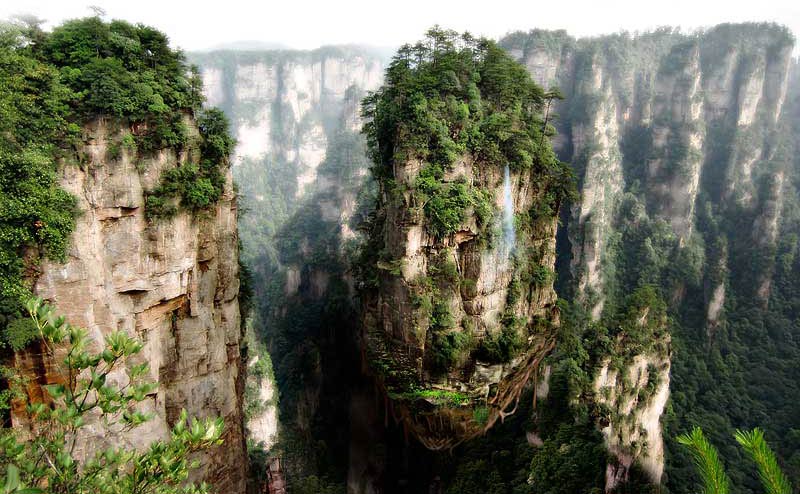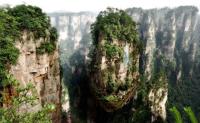Top 10 Otherwordly Stunning Destination
(Herman)Top 10 Otherwordly Stunning Destination 1. Mystical Mountains of China, Hallelujah Mountain The only possible way you could be forgiven for not knowing about 'Avatar' these days, is if you were living under a rock — the Southern Sky Column rock in Zhangjiajie, China, to be precise. At 1,074 metres tall, the towering column was the inspiration behind the floating mountains in James Cameron's movie 'Avatar.' Last year, Chinese officials hoping to capitalize on the movie's success re-christened the peak Hallelujah Mountain after the digitized versions portrayed on the planet Pandora. It's one of 3,000 narrow quartz-sandstone pillars in Zhangjiajie National Forest Park that seem to defy gravity and peek out through veiled clouds of mist and fog. Just goes to show, sometimes the most otherworldly scenery can be found close to home. 2. Lechuguilla Cave, New Mexico Deep in the bowels of New Mexico exists asubterranean chamber known as the Chandelier Ballroomfor its six-metre gypsum chandeliers which hang from glittery, snow-white ceilings. The cave is one of nature's finest works of art. With the luxury of time — measured in eons — nature has carved spectacular candelabra-like structures and intricate chandeliers from the walls and ceilings of the Earth's hidden passageways. The cave's Pearlsian Gulf, meanwhile, is named after 'cave pearls' — smooth, round pearl-like stones — which form in pools of water from calcium buildup. Unluckily for us, the caves are closed to the general public but are beautifully preserved on film by the BBC documentary 'Planet Earth.' According to the U.S. National Parks Service, Lechuguilla Cave is 489 m deep — the deepest limestone cave in the country. At 196 km long, it also ranks as the fifth longest cave in the world. 3. Valle de la Luna, Chile The best time of day to experience the otherworldliness of the Valle de la Luna — or Valley of the Moon — is at sunset, when the shadows creep up on the strange and mysterious rock formations and parched, barren dunes. Named after its lunar-like landscape, Valle de la Luna is set in Chile's Atacama Desert, considered the driest place on earth: some areas haven't seen a drop of rain in hundreds of years. In fact, while it may be a wasteland for any kind of life form, scientists have used the valley's desert-like conditions and rocky terrain to test Mars rovers. Guided tours of the landscape's labyrinthine caves and passageways are also available. Basic tours are about 2.5 km and take four hours. To add another intergalactic travel experience to the trip, stay the night and stargaze in the desert silence. 4. Matmata, Tunisia Take another look at the troglodyte structures built into the earth. If the artificial caves look familiar, it may be because they were featured in George Lucas' Star Wars movies. In particular, the Hotel Sidi Driss served as Luke Skywalker's home, the 'Lars Homestead,' and attracts pilgrimages by die-hard Star Wars fans around the world. The no-frills underground hotel still bears some of the original set pieces from the films. It's understandable why George Lucas chose Southern Tunisia to portray Luke's home planet of Tatooine. With its exotic desert landscape, foreign and unfamiliar crater and mud hut adobe homes, the region is just alien enough to convince viewers they were visiting a planet, far, far away ... 5. Wai-O-Tapu, New Zealand The landscape in this geothermal area is alive — and angry. An overactive imagination may even describe it as a beautiful, gentler, less sinister kind of hell on earth. First of all, upon arrival, visitors are hit by a wall of smells akin to rotten eggs — sulphur. The hot spot hisses with rising steam, and bubbles of latent anger rise to the surface. In some places, the earth groans in uncontrollable rage, exploding in a violent temper that shoots columns of hot water high into the air, before settling back down, most notably at the Lady Knox geyser. The Champagne Pool, meanwhile, is a bubbling hot spring — hence the name — bordered by a bright orange ring made from deposits of arsenic and antimony sulfides, a pool that measures 65 m in diameter, and 62 m deep. Aside from bubbling mud pools, there's also the Devil's Bath, aptly named for the ludicrously neon and seemingly unnatural shade of chemical green. Because if anyone were to take a dip in that kind of pool, it would have to be someone with a hardy constitution. 6. Dinosaur Provincial Park, Alberta It's our very own Jurassic Park. Only without the terrifying spectre of an actual dinosaur rising from the ashes. And OK, so it's a different period, but Cretaceous Park doesn't have nearly the same ring. In the badlands of Alberta is Dinosaur Provincial Park, a graveyard of prehistoric fossilized bones. Rock pinnacles called hoodoos populate the badlands, rising up like strange terra cotta and bronze sentinels bearing resemblances to mushrooms, pyramids, and even camels. Though it looks like a barren, semi-arid landscape now, 75 million years ago great rivers flowed through the region and gargantuan dinosaurs roamed the warm, temperate coastal plain. The mere idea just seizes the imagination, no? 7. Aurora Borealis, Islandia OK, OK, so we know it's not exactly a terrestrial landscape. But no one can deny that these northern light shows seem like unearthly phenomenon and have the ability to capture the imagination. Best seen in northern latitudes like the Canadian Arctic, Sweden, Norway, Alaska, Finland Russia and Greenland, auroras occur when highly charged electrons from solar wind collide with atoms in the high-altitude atmosphere. Fluorescent ribbons of light dance to an inaudible melody and gentle beat causing the sky to bend and ripple. Phenomenon like these remind us that there is a force much bigger than ourselves at play. 8. Crater of the Moon, New Zealand Despite its name, Craters of the Moon wasn't created by asteroid debris crashing spectacularly to Earth. Though it makes for a much more exciting story. Instead, all the steaming craters are the result of hydrothermal eruptions that started deep within the bowels of the earth. Craters of the Moon sits along a steam field north of Taupo, New Zealand, and gives people a feel for the power and heat of the Earth's core. Wooden walkways guide visitors and protect them from sporadic smoking chimneys — openings in the earth called fumaroles — as they navigate through curtains of rising steam. 9. Pamukkale Kusadasitv, Turkey From a distance, the white travertine terraces that cascade down the cliff appear like a winter mirage of ice and snow. In actual fact, Pamukkale — which means 'Cotton Castle' in Turkish — is made up of hard white mineral deposits from calcite-laden waters which form a 200 metre-tall cliff. Though the petrified, mineral shelves are off-limits to tourists, the nearby Sacred or Antique Pool is open to the public and allows visitors to swim above ancient Roman ruins that were felled by an earthquake in the 7th century and buried in a watery grave. The thermal hot springs are believed to be good for heart disease, blood pressure, rheumatism, skin conditions and atherosclerosis. 10. Lac Abbe - Djibouti (Africa) The flat, sandy moonscape environment of Lac Abbé in this African nation is pockmarked with limestone chimneys that stand as tall as 50 metres high, sprouting from the Earth as a result of calcareous deposits. The sweeping, dry landscape is home to the nomadic Afar people who share the banks of the lake with birds like flamingos, which gather at dawn. The region also served as the backdrop for the 1968 film 'Planet of the Apes.
04 Juni 2012 - 18:08:00 WIB
Dibaca : 1364




 Register
Register Login
Login





















